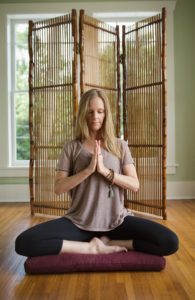by Jennifer French
 People often wonder what the difference between yoga and meditation is, believing that they are two separate practices. In truth, yoga has a long tradition that is thousands of years old and, originally, its main purpose in practice was to hone and develop meditative techniques. There was no separating the two. The breathing practices used in yoga and later, the physical postures, were tools to strengthen the body so that it would be more comfortable sitting in meditation for extended periods of time. Mediation was, and truly still is, just one aspect of a full yoga practice.
People often wonder what the difference between yoga and meditation is, believing that they are two separate practices. In truth, yoga has a long tradition that is thousands of years old and, originally, its main purpose in practice was to hone and develop meditative techniques. There was no separating the two. The breathing practices used in yoga and later, the physical postures, were tools to strengthen the body so that it would be more comfortable sitting in meditation for extended periods of time. Mediation was, and truly still is, just one aspect of a full yoga practice.
Today, yoga is often seen as a low impact, safe, and effective way to bring movement into our bodies. Meditation is seen as a way to quiet our busy minds. We learn more about the benefits of yoga and meditation every day. Just this month NPR reported on a study published in the Annals of Internal Medicine that showed how yoga can significantly reduce back pain. Time, NBC News, and Science Daily all reported on a recent study showing how yoga and other MBIs (Mind-Body Interventions) “can suppress the expression of genes and genetic pathways that promote inflammation” and “reverse the molecular signature of the effects of chronic stress.” The Journal of Alternative and Complimentary Medicine also published a study whose findings report a significant decline in depressive symptoms in the study’s participants.
Having the research to back up the benefits of yoga and meditation is encouraging. Yet the important thing to keep in mind is that they go hand in hand. As a yoga teacher, I often say in class, “What makes the shape that your body is in right now yoga?” You might find yourself sitting on the floor with a blanket under your hips or in a chair doing a simple spinal twist and hear the teacher’s voice ask this very question. The answer is simple. You are doing yoga because you are focusing and paying attention. In yoga, we are always working toward being in a kind of meditative state, that is we are directing our attention in a specific way to a specific point of focus. This point of focus may be our breath or sensations that are arising in our body or even a visual point of focus—which is especially helpful when practicing balancing poses.
What happens then when our attention is drawn away, when we get distracted? Are we still practicing yoga? Of course! As mentioned earlier, meditation is just one aspect of a full yoga practice. In the yoga world, we call this one of the “eight limbs” of yoga. Yoga poses are another limb, so is working with our breath, and quieting our senses. The limb or stage that comes just before meditation is developing concentration. The longer we are able to focus our attention the closer we come to meditation. We might start with just a few seconds, then work slowly to a few minutes. Our yoga posture practice soon becomes a moving meditation. There is no rush, and there is no end goal. This process is a journey, with many benefits along the way: pain and stress relief, flexibility and stability, a slower heart rate, and decrease in blood pressure to mention just a few.
If you are considering beginning a yoga and meditation practice, be sure to talk to a qualified teacher. Let them know what your concerns and expectations are, and ask for guidance as to what level of class you might start with. Yoga is a practice for everybody. And with the correct guidance you’ll not only keep your body safe, you’ll also find that as you learn to pay attention while on the yoga mat, you’ll begin to pay more attention while off the yoga mat.
Originally published in The Charlotte Sun: Feeling Fit, 2017.
